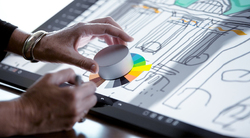
Ross Ufberg takes a deep dive into the design process behind Microsoft’s hyper-swiveling Surface Studio, a high-concept device that turns the desktop PC into a drafting table. A key ingredient to the project’s breakthrough success seems to be the highly collaborative, cross-disciplinary team that they corralled into Microsoft’s Building 87 to invent the thing:
Under one roof, Microsoft has united a team of designers, engineers, and prototypers, and invested heavily in infrastructure and equipment, so that Building 87 can be a self-contained hub, complete with manufacturing capabilities that usually would be located offsite or outsourced. Having these capabilities close at hand drastically cuts down on dead time, so that, in some cases, mere hours after a designer sends a concept down the hall to the prototypers, they can figure out a way to embody that concept, and print it in 3D or manufacture it on the spot. The model-making team can then hand that iteration off to the mechanical engineers, who assess the viability of the concept and figure out ways to improve it. It’s sort of like one endless feedback loop, with designers conceiving, prototypers creating, engineers correcting, and back again to the designers.
This is exactly the spirit of Big Medium’s own (far smaller) design teams. We have constant collaboration and feedback among product designers, visual designers, front-end designers, and developers. It’s not a linear process, but a constant conversation that blends experiments, false starts, grand leaps, successes, and gradual improvements. This turns out to be both faster and more creative.
In workshops and design engagements, we coach client organizations how to adopt this collaborative, iterative design process. Designers and developers often tell us at first that it feels unfamiliar, even uncomfortable, to collaborate across the entire design process—and especially when ideas are being formed. It’s natural to shy away from sharing before something is fully thought out. But that’s exactly where the most productive cross-disciplinary experiments happen.
One of Surface Studio’s signature design innovations is the hinge that lets it shift instantly from upright desktop monitor to a sloped, dial-and-stylus drafting board. In Ufberg’s telling, it wouldn’t have happened at all without a culture of cross-disciplinary experimentation.
“It is way easier to try something than tell somebody it can’t be done.”
When the idea of a hinge was first tossed out in a brainstorming meeting, [mechanical engineering director Andrew] Hill tells me, “there were ten different people who said that it doesn’t make any sense, it would be too complicated to make it work. But then a couple weeks later, we got a prototype out of our model shop where you could see the mechanism starting to come together, and the people who were saying it couldn’t be done started to come over and be like ‘Huh, maybe we could do something like this.’” I ask him if he was one of those doubters.
“One of the things that I found out about myself is it is way easier to try something than tell somebody it can’t be done,” he confesses. “There’s magic in the suspension of disbelief. If you just do stuff that you know you’re going to be able to do, you know where you’re going to go. If you try something that you’re not quite sure is going work, at least you’re exposed to new problems and you get smarter in that way, and in the good cases, you move the whole thing forward.” In its first iteration, the hinge was just a piece of cardboard glued crudely to a kickstand. But then, the feedback loop kicked into place.
The bottom line: When in doubt… don’t doubt. Build a quick prototype—the most low-fi thing you can create to test the concept—and then share it with people from other disciplines. It’s how you manage risk in an inherently risky exploration into the new.
That’s good advice not only for industrial design, but for pretty much anytime you’re really trying to make something new and better. And isn’t that all of us?
Need help transforming your organization’s design process for faster and more creative results? That’s what we do! Get in touch for a workshop, executive session, or design engagement.





